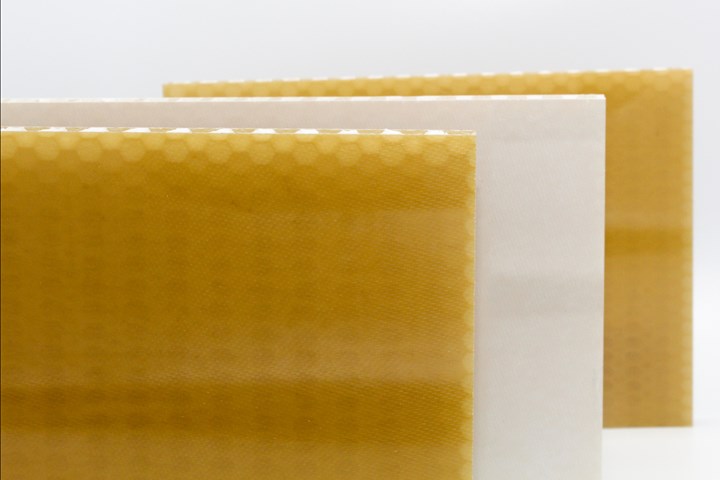EconCore, Toray and Bostik collaborate on FST-qualified thermoplastic honeycomb panels
Developed for mass transportation applications, including aircraft interiors, the material improves upon the cost, sustainability and versatility of conventional sandwich layup.

Photo Credit: EconCore
EconCore (Leuven, Belgium), Toray Advanced Composites (Morgan Hill, Calif., U.S.) and Bostik (Milwaukee, Wisc., U.S.), reported on Sept. 7 the company’s collaboration to develop a thermoplastic honeycomb core sandwich panel for use in mass transportation applications, including aircraft interiors.
A combination of Toray’s Cetex-reinforced thermoplastic laminates as skins, EconCore’s thermoplastic honeycomb core based on thermoplastic chemistries with fire, smoke and toxicity (FST) qualifications and Bostik’s flame-retardant thermoplastics polyester web adhesive, the novel material has already passed FST regulations applying to aircraft interiors.
The development was in lieu of providing a sustainable solution to more expensive and labor-intensive fabrication of parts based on conventional sandwich layup, such as that of phenolic prepreg skins and phenolic-impregnated aramid honeycomb core. Compared to thermoset resins, which are said to require lengthy and expensive handling and processing of the sandwich components, EconCore points to its thermoplastic technology, which is said to take around 60 seconds to form the desired shape. In addition to shorter processing times, Econcore’s thermoplastic honeycomb skin is considerably more sustainable and can be easily recycled, shredded and repurposed into composites.
“We are excited about this collaboration, especially as we have been able to develop a sustainable technology that is recyclable and which, next to the automotive and transportation applications, has the potential to be used in a variety of markets such as rail, aviation or ship building,” says Tomasz Czarnecki, COO of EconCore. “With the FST thermoplastic honeycomb technology, we are looking for cost savings at both ends; within the continuously produced honeycomb core and panel, as well as within the fast, easy and clean conversion of a sandwich panel into a lightweight sandwich part.”
According to the companies, while the thermoplastic honeycomb core and skins are often welded to each other within EconCore’s technology, the use of adhesive from Bostik enables for the reduction of lamination temperatures and processing simplifications. Further, the traditional phenolics usually used for curing, replaced with the company’s web adhesive which is flame-retardant, is said to provide a unique way of application which Bostik says opens new possibilities to produce lightweight materials.
With a clean bonding process, suitable for lightweight materials, EconCore’s technology is reportedly versatile with regards to the type of thermoplastic materials applied as well, which further enables optimization of the product toward specific applications.
Related Content
-
Hexagon Purus Westminster: Experience, growth, new developments in hydrogen storage
Hexagon Purus scales production of Type 4 composite tanks, discusses growth, recyclability, sensors and carbon fiber supply and sustainability.
-
Microwave heating for more sustainable carbon fiber
Skeptics say it won’t work — Osaka-based Microwave Chemical Co. says it already has — and continues to advance its simulation-based technology to slash energy use and emissions in manufacturing.
-
Natural fiber composites: Growing to fit sustainability needs
Led by global and industry-wide sustainability goals, commercial interest in flax and hemp fiber-reinforced composites grows into higher-performance, higher-volume applications.
















